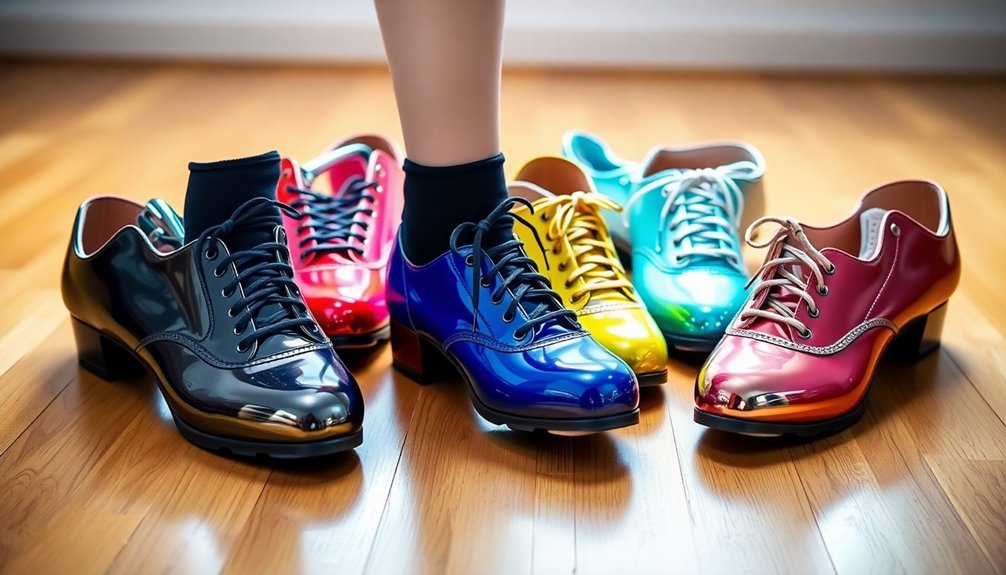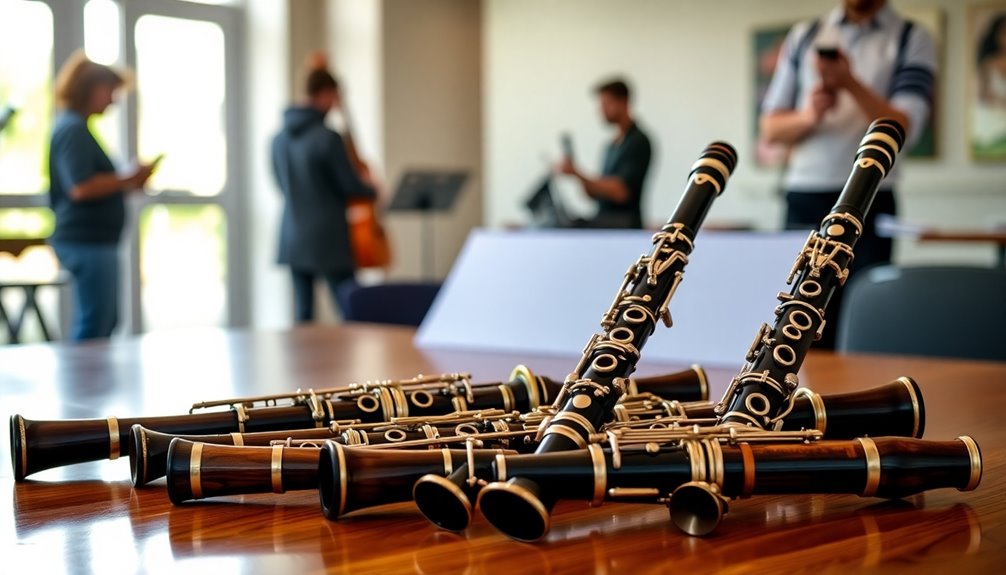When you're serious about tap dancing, the right shoes can elevate your performance. Consider styles like oxford for stability or the elegant Mary-Jane for advanced techniques. Full-sole shoes are great for beginners, while split-sole options enhance flexibility for experienced dancers. Pay attention to comfort and fit; a snug shoe helps with precision and reduces discomfort. Materials like leather offer durability, while synthetic options are lightweight and easy to maintain. To truly succeed, you'll want to choose wisely based on your skill level and personal needs. Stick around to uncover more crucial tips on selecting the perfect pair!
Key Takeaways
- Choose tap shoes based on your skill level, with full-sole options for beginners and split-sole styles for advanced dancers.
- Prioritize comfort and fit, ensuring a snug feel to enhance performance and prevent injuries during dance routines.
- Consider the shoe material, as leather offers durability and sound quality, while synthetic materials are lightweight and easier to maintain.
- Evaluate heel height, with lower heels recommended for beginners to promote stability and higher heels for advanced techniques.
- Regular maintenance of taps and soles is essential to preserve sound quality and prolong the lifespan of your tap shoes.
Tap Shoe Styles Overview
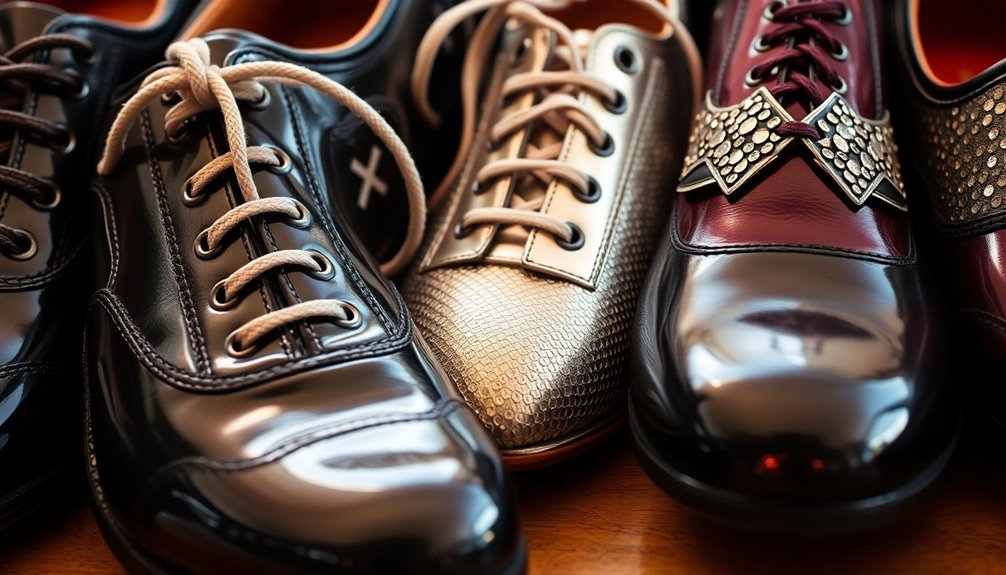
When it comes to choosing the right tap shoes, understanding the various styles available can make all the difference in your performance and comfort.
The Oxford style is a classic choice, featuring a low, lace-up design that offers ankle stability and long-lasting support, making it suitable for both beginners and experienced dancers. This style is especially beneficial for upper levels as it provides enhanced support during complex routines.
If you're looking for something a bit more elegant, the Mary-Jane style might catch your eye. With a strap across the instep and an elevated heel, it provides a secure fit and encourages graceful pivoting and spins, often favored by advanced dancers.
For those who appreciate fluid movements, the Jazz style combines features of a classic jazz shoe with tap plates, allowing for nuanced sounds and enhanced flexibility. It's lightweight and ideal for advanced tappers.
Lastly, if you need maximum flexibility, consider the Flex style. Its split sole construction enhances foot articulation, making it perfect for performing complex footwork while ensuring comfort.
Each style serves unique needs, so think about your dance level and preferences to find the perfect pair that fits your tap dance journey.
Essential Features to Consider
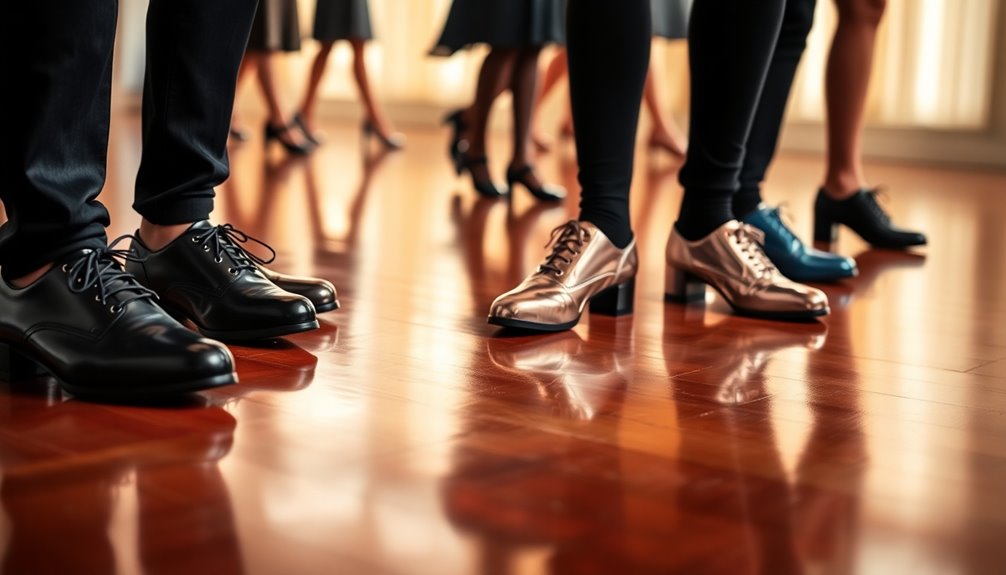
Choosing the right tap shoes involves considering several essential features that can impact your performance and comfort.
First, think about the sole type. Full-sole shoes offer stability and support, making them ideal for beginners or those who prefer powerful tapping. However, if you're more advanced and enjoy intricate movements, split-sole shoes provide the flexibility needed for dancing on your toes.
Next, focus on comfort and fit. Look for padded collars and moisture-absorbent linings to keep your feet comfortable during performances. Make sure the shoes fit properly; they shouldn't be too small or too large, and secure fit options like lace-ups or elastic buckles can help them stay on during energetic classes. When selecting tap shoes, consider the size options available, especially to ensure a proper fit for your foot's width.
Don't overlook tap plates and sound quality. Riveted plates are great for beginners, while adjustable plates let you customize your sound.
Finally, consider heel height. Low heels are recommended for beginners to promote stability, while higher heels can enhance your technique and confidence. Always follow your studio or teacher's recommendations regarding heel height to ensure you're making the best choice for your skill level.
Materials and Their Maintenance

The materials used in tap shoes play a significant role in both their performance and maintenance.
Leather is renowned for its durability and breathable qualities, keeping your feet cool during intense practice. It produces a warm, resonant tap sound but requires regular cleaning and conditioning to maintain its quality. Be cautious, though—leather can stretch excessively, which may lead to loose shoes and potential blisters. Additionally, the choice of material directly impacts longevity and comfort, making it crucial for dancers to select the appropriate type based on their needs.
On the other hand, synthetic materials like polyurethane and microfiber are lightweight, flexible, and waterproof, protecting your feet from moisture. They're easier to clean and maintain, needing just a quick wipe down. However, they're less breathable, which might lead to sweaty feet and discomfort.
When it comes to upkeep, regularly inspect your taps and soles to ensure they're securely attached.
Leather requires consistent care to extend its lifespan and sound quality, while synthetic shoes need minimal attention. Remember to store your shoes properly to prevent damage.
Importance of Fit and Comfort
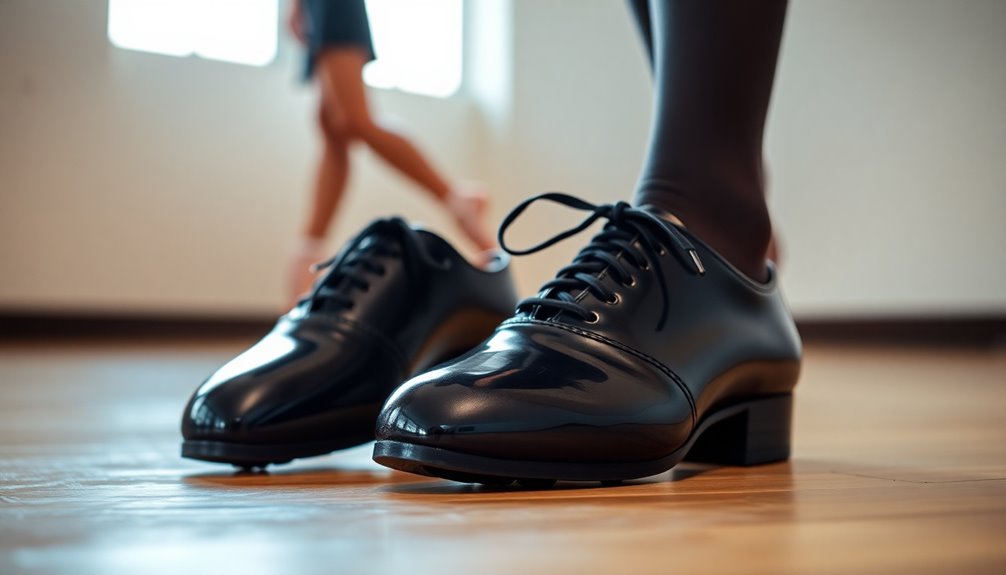
How crucial is the fit of your tap shoes to your performance? It's vital. A snug fit ensures optimal shock absorption, tap precision, and overall comfort. Tap shoes should feel tighter rather than looser, as they'll mold to your feet over time.
If you notice discomfort on the sides or if your toes bend or overlap, your shoes are too tight. A proper fit helps you control and fine-tune your footwork, especially at advanced levels. The ball of your foot should sit over the front tap for the best control. Additionally, proper fit is essential as it impacts not only comfort but also the overall sound quality produced by the taps.
If you're a growing dancer, leave about a thumb's width of space in front of your toes to accommodate growth. You can use heel grips or thick socks to fill extra space, but if your shoes slip, they're too big.
Ill-fitting shoes can lead to blisters, bunions, and even affect your technique. Comfort is key; your tap shoes should feel good from the start. Look for firm heel cups and supportive arches without discomfort.
Lace-up styles offer ankle support, while low heels are easier for beginners. Choose wisely, as the right fit can elevate your dancing experience.
Understanding Sound Quality
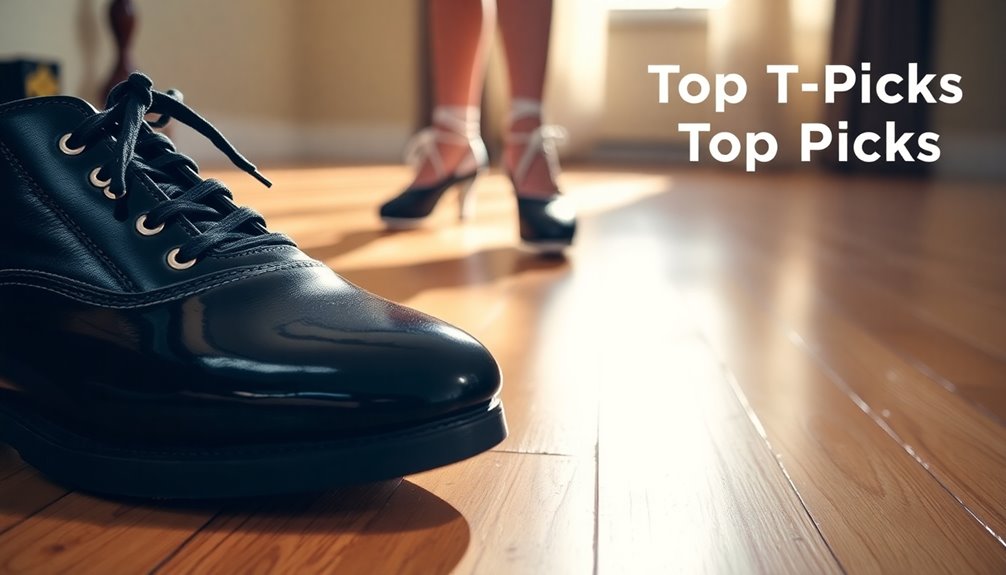
Finding the right fit in tap shoes not only enhances comfort but also affects the sound you produce while dancing. The material of your tap plates plays a crucial role; metal plates deliver a loud, crisp sound, while synthetic options offer a softer, more muted tone. If you prefer a brighter sound, go for metal plates like those from Capezio or So Danca.
The size and style of the taps also influence sound quality. Larger taps can create a louder noise but might sacrifice comfort, whereas smaller taps allow for more control and precision. Styles like convex or flat will further affect how your sound resonates. Tap size should match dancer's foot width and personal preference to optimize performance.
Maintenance is key to achieving the best sound. Regularly check for loose screws, as they can lead to poor sound quality. A sound board can help stabilize these screws, and wood glue can secure stripped holes.
Finally, consider your shoe type and its interaction with the dance surface. Leather shoes typically produce a clearer sound, while heavier shoes may amplify volume. Choosing the right combination will enhance your tap experience, allowing you to express yourself through sound as well as movement.
Top Brand Recommendations
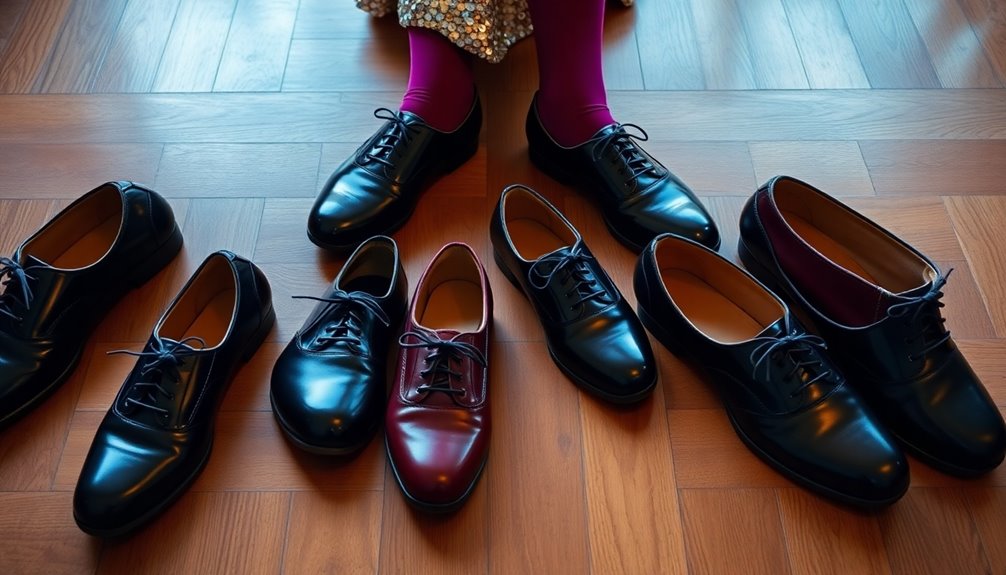
When it comes to choosing tap shoes, several brands stand out for their quality and performance. Capezio is a favorite among dancers, offering a wide range of styles for all skill levels. Bloch is respected for its comfortable and durable options, making it ideal for both recreational and professional dancers. If you're looking for style combined with functionality, So Danca's innovative designs are worth considering.
Sansha provides a diverse range of tap shoes suitable for various dance styles, while Roch Valley offers affordable options without sacrificing quality, perfect for beginners. For professionals, Miller & Ben is a top choice with high-end, handcrafted tap shoes known for their quality. Grishko also delivers attention to detail, making their shoes popular among dancers who appreciate craftsmanship.
The Capezio k360 is a high-end model favored for durability and sound quality, while Laduca's high-heeled options cater to those who want elegance. Quality materials are essential for ensuring the longevity of your shoes, especially for dancers who practice frequently. For beginners, Leo's Dancewear and Dance Class offer affordable, durable options, and Bloch's entry-level shoes like the Jason Samuel Smith tap shoe are great for comfort.
Choose the brand that fits your needs, and you'll be well on your way to achieving tap dance success!
Tips for Choosing the Right Pair

Choosing the right tap shoes can make all the difference in your dancing experience. Start by considering the sole type: full-sole shoes offer stability and support, perfect for beginners who prefer a powerful tapping style. Full-sole shoes are particularly recommended for those just starting their tap dance journey, as they help build confidence in movement.
If you're more advanced and need flexibility, split-sole shoes are your best bet, but they require stronger feet.
Next, think about style. Oxford shoes are versatile for all skill levels, while Mary Jane styles are ideal for young dancers, providing security.
If you're aiming for smoother movements, jazz tap shoes combine jazz functionality with tap plates.
Material matters too. Leather shoes are durable and mold to your feet for comfort, while synthetic options are budget-friendly but may lack quality.
Canvas shoes are breathable, and rubber shoes are great for practice.
Finally, ensure a proper fit. Tap shoes should feel snug for optimal performance.
Beginners should stick to a lower heel height to avoid strain, while more experienced dancers can opt for higher heels to enhance their technique.
Pay attention to the topline, as it affects flexibility and stability. Choose wisely, and you'll be tapping your way to success!
Frequently Asked Questions
Can I Wear Tap Shoes for Other Dance Styles?
You can't wear tap shoes for other dance styles effectively.
They're designed for the unique sounds and movements of tap dance, which makes them unsuitable for ballet or jazz. The metal plates and bulkiness hinder flexibility, while the sound produced isn't desirable in those styles.
Each dance form requires specific footwear for comfort and technique, so it's best to stick to appropriate shoes for what you're dancing.
How Do I Break in New Tap Shoes?
To break in your new tap shoes, start by creasing the toes to loosen the material.
Wear them around your house with thick or double-layer thin socks to help them mold to your feet.
Use a hair dryer on medium heat for added pliability, but avoid wearing them immediately afterward.
Regularly practice dancing and walking in them to create creases, and protect potential blister spots with bandaids or tape for comfort.
Are There Specific Tap Shoes for Children?
Yes, there are specific tap shoes designed for children.
When you're shopping, look for features like soft PU leather for durability, cushioned footbeds for comfort, and adjustable fasteners for a secure fit.
Brands like Capezio and Bloch offer great options.
You'll also find various sizes and styles to suit your child's preferences.
Ensuring the right fit is essential, so follow sizing guidelines to help them dance comfortably and confidently!
How Often Should I Replace My Tap Shoes?
You should replace your tap shoes based on how often you dance and their condition.
If you're a frequent dancer, consider replacing them every 3 to 6 months. Casual dancers might get away with once a year.
Keep an eye out for signs of wear, like sole damage or loose plates. Regular maintenance can extend their life, but once they start affecting your performance, it's definitely time for a new pair.
Can I Customize the Taps on My Shoes?
Yes, you can customize the taps on your shoes! Brands like Miller & Ben and So Danca offer various customization options.
You can choose from different tap styles, materials, and even fine-tune the taps for your preferred sound.
With Miller & Ben's Custom GS1 Tap Shoes, you can attach Super Sonic Taps, while So Danca provides options for pad types.
Explore these possibilities to create the perfect pair that suits your unique dancing style!
Conclusion
In your journey to find the perfect tap shoes, remember to prioritize fit, comfort, and sound quality. By considering the essential features and materials outlined in this guide, you'll be well-equipped to make an informed choice. Don't forget to explore top brand recommendations to ensure you're getting quality footwear. With the right pair, you'll dance your way to success, expressing yourself with every tap and step. So, lace up and let the rhythm take over!
